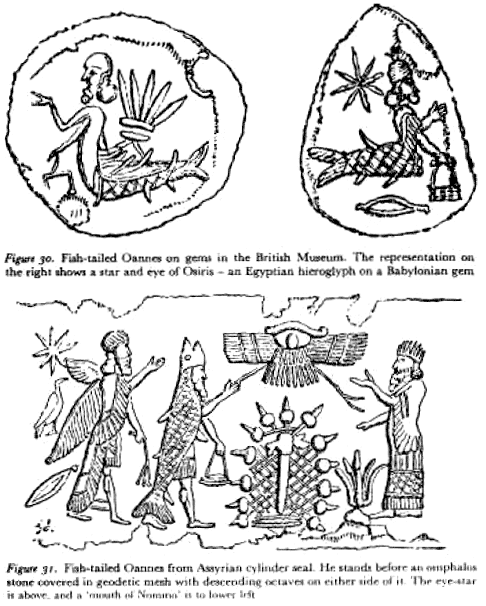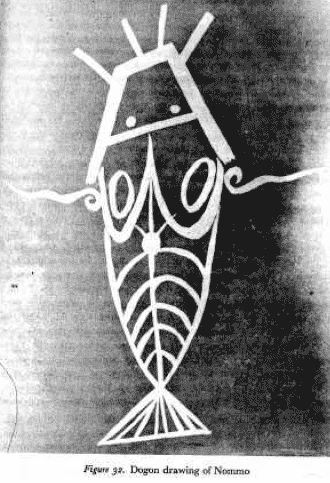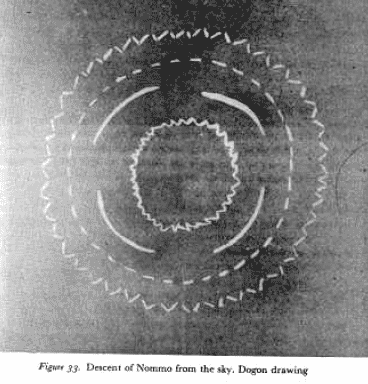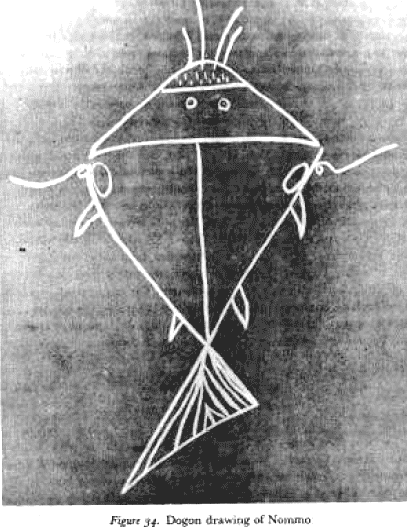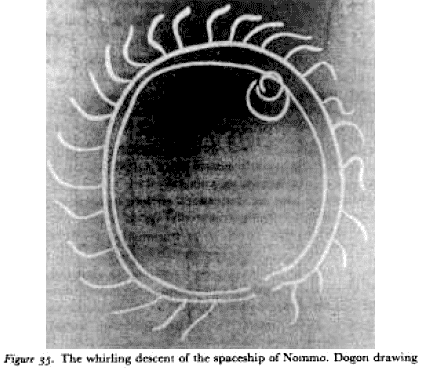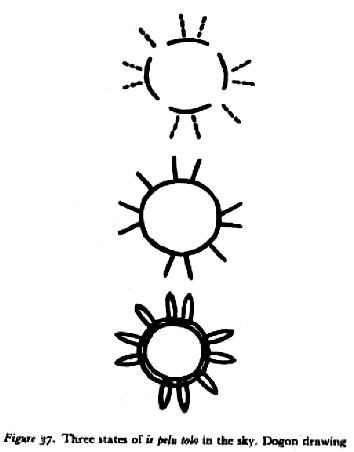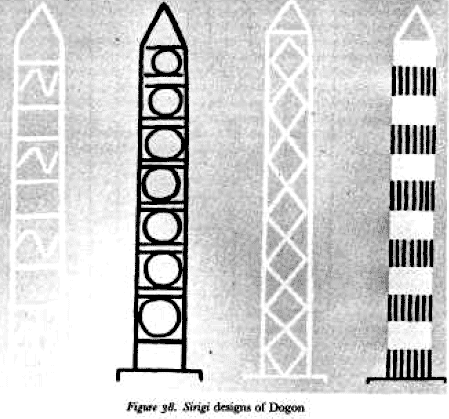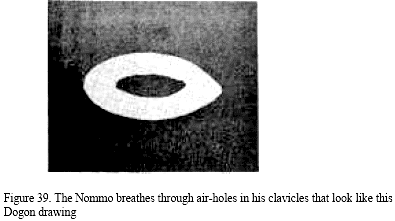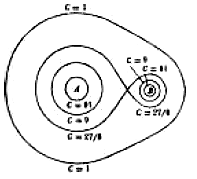|
A Fable
Some seaweed it seemed to be trailing
with it showed through the water. It was a bright, almost shiny,
porpoise ... it was now near the sand . . . what would it do? She
could see it now, through the water. It stopped. It seemed to be
groveling in the sand. Its tail splashed up, then down. It remained
stationary.
The little girl was worried about the fish. 'Have you got hold of the dolphin?' she asked the woman. Just beneath the woman's shoulders there was a noise like a swimming suit strap snapping against her skin. She replied to the girl with a fixed stare and a high wail which seemed to be a song. She moved towards the girl, her eyes never straying from her. Her eyes were clear blue, like the sky.
It was as if there were two holes in her head and you could see the sky through them. Again her swimming suit strap snapped against her. Her eyes were like the hot sun. The girl wanted to go to sleep. The woman's eyes were like the sound of the surf. The girl sat down in the sand and tried to make herself see the woman more clearly.
The woman's face appeared to be really
silver.
She stared at the girl and remained motionless, except for a slight swaying to and fro.
The woman gave a long wail, but the expression on her face did not change. Then there was the snapping of the swimsuit again. But this time the girl saw that above the woman's bosom were two long thin slits, which had opened and snapped shut loudly as if they were muscles flexing, just under her beautiful sleek collarbones. The woman stirred as if she were resting uncomfortably on a high stool.
She looked dissatisfied and, twisting
her torso, she leapt forward and fell with a splash in the surf near
where the girl sat. She had no legs. It was what the girl had
thought was the dolphin. The woman was a mermaid. Her body stretched
out long, sleek, shiny in the sun, with the surf rushing up past her
and then retreating. She leaned on an elbow and raised her dolphin's
tail slightly in the air, then tapped the shallow water, and did so
several times in the way that the girl herself tapped her fingers on
her desk at school sometimes.
The girl liked the mermaid. She had never seen anyone so smooth and silvery and beautiful.
The girl began to walk away.
And she made every effort to smile and signal her
intentions. The woman seemed to nod in agreement. The girl ran
quickly, looking back often to see if her mermaid woman would wait
for her. The mermaid made no attempt to move, but merely watched the
girl.
Then suddenly the thing in the surf moved. It was horrible, like a serpent.
But the little girl eluded her and ran towards the sea.
Feeling sick in the pit of her stomach and apprehensive, the mother followed her daughter and feebly called after her. The girl quickly reached her friend from the sea, and the mother, seeing her standing beside the moving creature, cried,
She then ran and — it was a woman and fish, it was! It was silver. It was a mermaid!
Her daughter came to her obediently and the mother stared in disgust and nausea at this awful slimy sea creature with a grotesque human frame grafted on to it - a monster, an abomination. She felt her stomach constrict, she gasped, she bent forward in the thought that she would be sick.
Her mother was choking, eyes bulging, stumbling towards her with her flat palm outstretched to push her away towards home.
They heard a loud splash and turned just in time to see the mermaid slip away effortlessly at lightning speed into the deep water gone instantly from sight.
The mother looked at her daughter as if the girl might at any moment herself turn into a mermaid.
A little story about a child and an adult and their different
reactions to a strange, intelligent amphibian. To the child 'it
could swim better' and was silvery and fascinating. To the mother it
was repulsive and horrible.
The readership would have been the cosmopolitan inhabitants of the Hellenistic world created by the conquests of Alexander.
In his work, Berossus describes his country's tradition of the
origins of its civilization. And the tale is a strange one. For a
group of alien amphibious beings were credited by the Babylonians
with having founded their civilization.
But in the Berossus fragments preserved by the historian Apollodorus, we read that,
This seems fairly clearly to be a corrupted form of 'Dagon'. Unless
'Dagon' is a corrupted form of 'Odacon'.1
This is an extremely important point, as we shall now see.
Berossus, according to the close account of Apollodorus, calls the amphibians by the collective name of 'the Annedoti'. They are described as 'semi-daemons', not as gods. For some time I thought that 'the Annedoti' must be a convenient and tradition-sanctioned name for these creatures. I was concerned to have a name for them because, as we learn in a moment, the Dogon tribe claim that amphibious creatures with fishtails founded their civilization too, and that they came from the system of the star Sirius.
If there are intelligent creatures
living on a planet in the Sirius system, it would seem from all the
evidence that they are amphibious, resembling a kind of cross
between a man and a dolphin. It is therefore necessary to come up
with some name for these creatures if we are to discuss them from
time to time.
I read once again the fragment of Berossus from the careful Apollodorus and scrutinized the translation of it, which was:
The Erythraean sea is that body of water
known to the ancients which we today subdivide into the Red Sea, the
Persian Gulf, and the Indian Ocean.
These are all reasons why I felt that I
should include as an appendix to this book the complete surviving
fragments of Berossus (excluding a couple unrelated to our concerns
which may be found in the third and final, 1876 posthumous edition
of Cory's book). For unless all of the material is available and
easy to hand, one invariably overlooks something and neglects to
make the frequent and necessary comparisons which enable one
gradually to read between the lines and obtain additional insights.
And the version preserved by Abydenus uses the word 'annedotus' only as if it were a proper name:
As for the word 'musarus', Abydemis does
not use it at all.
A 'musarus' is 'an
abomination', and an 'Annedotus' is a 'repulsive one'.
If ever anything argued the authenticity of their account, it was this Babylonian tradition that the amphibians to whom they owed everything were disgusting, horrible, and loathsome to look upon. A more normal course for any invented tradition of the origins of civilization would have been to glorify the splendid gods or heroes who founded it. But instead we find specific descriptions of 'animals endowed with reason' (Alexander Polyhistor's account) who make their awed and thankful beneficiaries want to be sick with revulsion.
And what is more, the tradition
admits this freely!
As humans, we tend to dislike all slimy creatures, creepy-crawling creatures, creatures which ooze or slither or wriggle. Indeed, people who have a pronounced fondness for such creatures often seem to be suffering from a pathological condition themselves.
I once knew a girl who kept a pet
boa-constrictor in her bedroom, next to her bed for 'company'. She fed it a live mouse every Thursday
and she loved to watch it being eaten alive. She loved more than
anything to hear the snake at night in the dark when it made a
curious slithering fall against the side of its tank; this excited
her greatly. Now, I do not wish to criticize the girl for her
strange tastes but I think most readers will agree that the girl had
somehow transformed the interest in a snake into something else. And
that kind of substitution is the promotion of a fantasy which can
probably be classed as pathological, though possibly not dangerous
to anyone (except the mice).
Indeed, when all other pleasures in life
fail, the one remaining is a delight in irony. I recommend it, both
to men and Annedoti.
Who was Berossus, and how reliable was he? It is best to quote Cory's own preface for the information:
As for two of those later writers who preserve fragments of Berossus, Abydenus the disciple of Aristotle wrote an Assyrian History, now lost, and Megasthenes wrote an Indian History, also lost. None of the four writers who have preserved Berossian fragments has had any of his own writings survive intact either. Later writers such as Eusebius, the Christian historian of the fourth century a.d., and Syncellus, the ninth-century a.d. Byzantine historian, have preserved in turn all of the fragments of Berossus which the earlier writers had quoted in their own works.
For it seems that the original of Berossus was lost long before the originals of Abydenus, Apollodorus, Megasthenes, and Alexander Polyhistor. And unless some obscure Byzantine monkish library or Egyptian papyrus of Hellenistic date or Babylonian tablet produces new fragments, we may never know more about Berossus than we do now at third hand. But at least my Appendix II should be a help.
For it will be the first time since 1876
that the fragments of Berossus will have been published.5
The god of the universe, Amma (whose name I feel certain is a survival of that of the god Ammon of the Oasis of Siwa), sent the amphibians to earth. They are called the Nommos. But just as the Babylonians tended to speak of Oannes, the leader, instead of always saying 'the Annedoti' collectively, the Dogon often just speak of 'Nommo' or 'the Nommo' as an individual.
The Nommos are collectively called 'the Masters of the Water' and also 'the Instructors', or 'the Monitors'.
They have to live in water:
The Dogon describe the sound of the landing of the ark. They say the 'word' of Nommo was cast down by him in the four directions as he descended,* and it sounded like the echoing of the four large stone blocks being struck with stones by the children, according to special rhythms, in a very small cave near Lake Debo.8
* The reader will recall that near the end of Chapter One I mentioned that 'the word' represents a concept like the logos to the Dogon, for it means 'air'. We may take this description to refer not only to noise but to a rushing wind.
Presumably a thunderous vibrating sound
is what the Dogon are trying to convey. One can imagine standing in
the cave and holding one's ears at the noise. The descent of the ark
must have sounded like a jet runway at close range.
The descriptions of the landing of the ark are extremely precise. The ark is said to have landed on the earth to the north-east of Dogon country,7 which is where the Dogon claim to have come from (originally, before going to Mande) and that is, of course, the direction of Egypt and the Middle Hast in general.
The latter is much like the Babylonian tradition of their god
Ea (Enki
to the Sumerians), whose seat was also in the water, and who is
sometimes connected with Oannes.
They say:
And consequently a bit of folklore:
There seems to be a use by the Dogon of 'spurting blood' to describe what we would call 'rocket exhaust'.
And let us remember that, short of anti-gravity machines (which may be impossible), rocket propulsion is likely to be used by craft landing on any planet, no matter how sophisticated and non-rocket-like the interstellar main craft, or no matter how immensely advanced the civilization may be which is making a landing on a planet.
For the principle of the rocket is a simple one unlikely to be dispensed with entirely in any foreseeable future technology.
Actually, the Dogon seem to make a clear differentiation between the ark in which the Nommos actually landed on earth and what we may surmise was the true interstellar spaceship hovering above in the sky at a great distance, and which the Dogon seem to describe as appearing in the sky as a new star, and leaving with the Nommos at their departure from Earth.
In fact, this is the sort of arrangement
one would expect. An interstellar spaceship would probably look like
a bright new star, possibly visible in daytime as well as by night,
and the landing craft would be simple rocket-propelled craft not so
different in principle from machines which we use at the present
time for landing on the moon.
If we went to another inhabited planet, would we waste either time or resources on such apparent nonsense?
What seems to be lacking in UFOs is purpose, of any kind, which could conceivably fit into a framework of extraterrestrial visitation. So I therefore do not believe that 'flying saucers' are spacecraft, although I am willing to admit I may be wrong.
I have encountered nothing but flak from both sides about this believers in flying saucers are incredulous that I am not one of them, since I have written a book on extraterrestrials and I even maintain that spaceships visited Earth in the past; those who do not entertain for one moment the notion that spaceships could ever have visited the Earth naturally assume that my book is about flying saucers.
I should add, however, that I feel certain that the Earth is being monitored at this moment by a more advanced extraterrestrial civilization, and I assume this monitoring must be by automatic computer probes left behind in this solar system at some time in the past.
Although I consider most so-called
UFO sightings as pure hysteria or simple error, it is possible that
a small percentage of UFOs may be what the devout 'believers' in
UFOs claim they are. It is unfortunate that this subject has become
so burdened by the oppressive enthusiasm of people whom I can only
describe by the unflattering epithet of 'the lunatic fringe'.
This would seem to be a rocket craft landing on earth. But this 'spurting blood' (flame ?) is said to be shared with ie pelu tolo, and 'gave the star reality and brilliance'.13
For three different complementary tribal
drawings ie pelu tolo, see Figure 37. These seem to represent the
'star' in three separate conditions, differing in the amount of
'spurting blood' being emitted by the presumed spacecraft. The Dogon
also describe this 'star' specifically as having a circle of reddish
rays around it, and this circle of rays is 'like a spot spreading'
but remaining the same size.14
It should thus not surprise us that,
In other words, the 'star' is not a star, and can only be seen when the Nommo returns and his ark descends to Earth.
There are three other distinct kinds of Nommo, each personified as an individual.
The name Nommo comes from a Dogon word linked to the root nomo, 'to make one drink'. It is said:
He was crucified on a kilena tree which
also died and was resurrected.24
The hollow then filled with water. However, an untoward incident then occurred:
The bad 'water-insect' was thus unsuccessful in wishing to do harm. When the water filled the pond, the ark floated on it like a huge pirogue. ... It is said:
From then on he was called O Nommo, 'Nommo of the pond', - through respect men will not utter this name, but will call him instead di tigi, 'master of the water'.28
Thus we see that the second and third
categories of Nommo are really the same, but represent successive
states. And as for the future:
The descent of the ark was like a lozenge, its impact was like a rectangle.33 Perhaps this is why the Dogon say:
So maybe the Dogon have actually drawn a
rocket ship.
Let us visit the planet of the
amphibians.
We know that they revolve around a common centre, which is in fact equivalent to Sirius B revolving around Sirius A in an elliptical orbit.
Sirius A, a big, bright star, has two
and a half times the mass of our sun. Sirius B has ninety-five per
cent of the mass of our sun, but because it is made of degenerate
matter and is so tiny, this is not obvious. If Sirius B with its
mass were not a white dwarf, we could easily see it from earth as a
star of magnitude 2, though the problem of parallax would make it
difficult to separate it from Sirius A. In any case, if Sirius B
were on its own somewhere at its distance from earth, and were not a
white dwarf, it would be one of the brightest stars in the sky.
As for the actual size of Sirius A, its radius is a little more than one and a half times the sun's radius. This means that Sirius will be smaller in the sky than our own sun, seen from the planet. It will be a good deal smaller, but will need to have roughly the same amount of heat, which is not too difficult, considering how terribly hot and bright it is. To us it would be a strange experience to see such a small body in the sky giving out so much heat and light. Looking directly at it would probably be as injurious as staring into an arc lamp.
All the more reason to be under water,
and not so tempted.
Therefore intelligent life is likely to have evolved as amphibious and never have taken to the land. These amphibians might easily inhabit the surface of the water, of course, for they would need to breathe atmosphere and would not have gills like fish - they would probably need to be mammals of some kind in order to develop the brain sizes and other characteristics necessary for intelligence.
They would probably spend a lot of time hanging about marshes and might have developed an indigenous way of life originally which involved the use of woven reeds for huts and transport, and so on. (They would long ago have got past that stage, of course.)
But perhaps their first style of life,
to which they may even look back with some nostalgia as 'the good
old days of simplicity and a carefree existence', was something like
that described by Wilfred Thesiger in his book The Marsh
Arabs 37 in which the inhabitants of southern Iraq are pictured
in the marshes of the lower Tigris and Euphrates (quite near where
Oannes and his friends are said to have spent most of the time, one
is tempted to note!).
Your blowhole would open and close almost
instantaneously and your breathing would tend to be infrequent but
loud and quick. The blowhole might be placed in such a way that it
consisted of one or of two small slits, long and thin, just beneath
your clavicles (collarbones). In fact, the Dogon have a tradition
that their Nommos breathed through their clavicles.38
Because you would frequent the surface of the water a great deal, there would inevitably be a considerable contrast between the top half of your body and the bottom half.
The tradition known to us of the mermaid expresses this state of affairs quite well. Your lower extremities would be quite fish-like, but you would have articulate limbs and fingers on your upper half and your skin would be more capable of resisting solar radiations and hence would be more like that of a land mammal.
Probably cartilaginous structures would
have evolved in your head to rigidify your features beyond the
simple streamlined form required for a strictly undersea life, and
there would be something on your upper body resembling hair -
perhaps like the hair of our own walruses.
Overpopulation is not one of your
problems because most of your planet is water and all of the water
is habitable. Even on the planet Earth, it is estimated that
dolphins outnumber human beings two- to-one, and the oceans are
hardly overcrowded.
And as an amphibian you have exceedingly well developed senses of smell and taste. You 'taste' smells or spoor-substances underwater at enormous distances and though your sense of smell is not quite as acute, it is competent enough. Unlike yourself, human beings tend to have areas in or near their dwellings which smell of their excrement and urine - places to which they habitually return to perform these functions.
As an amphibian whose waste products
dissipate in the water, you find such an idea revolting. How can
human beings stand going back to those same odors day after day?
They can climb trees and cliffs, all of which is terribly impressive. They can go at a great speed on land with what they call 'running', they even have a certain capacity to jump over obstacles; they are not as swift on land as you are in water, but they do passably well. You do have difficulty in seeing them sometimes because, as you are in a watery environment, your vision is not good at long range.
And the humans, being dry, do not stand out against their background as much as you could wish. When they move you can instantly detect motion without optical definition, but a stationary human who is even approximately camouflaged and blends with this background is impossible for you to differentiate with your unaided eye. You rely on your sense of smell, like a rhinoceros.
But when the wind is against you, you
have no hope. A human can easily elude your perception on dry land
if he knows what he is doing and you do not have your goggles or
technical aids with you.
You have a phenomenal conceptual and
generalizing faculty. It is easy for you to conceive of invisible,
and even imperceptible, forces, because your daily environment is a
suggestive, allusive one. You taste and smell your ambience rather
than see it. Your powers of telepathy may be extremely highly
evolved - possibly a characteristic of your species from their
earliest history.
A more generic and neutral term, I suppose, would be simply the 'Sirians'. If we ever come into contact with them again, they will probably be called the 'Sirians' officially, and their civilization will be the 'Sirian civilization'. Their art will fall under the heading of 'Sirian culture' and their technology will be 'Sirian technology'. But what about their religion? There's a delicate point.
It will be called the 'Sirian religion' and we will try to pretend it has nothing to do with us. But inevitably we will have to take into account that, whereas 'cultures' and 'technologies' can be localized, the greater problems of the nature of life itself and of an individual's relation to the universe - existential problems - are not localizable.
There will in fact be no such ultimate thing as 'Sirian religion' except in the ethnographic sense. To speak of a 'Sirian' God will get us into deep waters. What do we mean when we speak of a 'Jewish' God or a 'Christian' God? There is no doubt that it is at the level of our deepest concerns - our religious and philosophical ones - that contact with an extraterrestrial civilization will make its deepest impact on us.
And it is at this friable level of our
preconceptions that we are most vulnerable. Here the foundations of
our beliefs can crumble with the first shock wave. Here the entire
edifice of our civilization can give way. Only by being prepared can
we safeguard our own cultural integrity.
It is quite true, as Carl Sagan says:
The critical studies should be institutionalized by the governments of the major powers, and made official programs. The resources of the governments which pour into programs to prevent their countries being overrun by military invasions, chemical warfare, nuclear blasts, should also pour into programs to prevent our planet as a whole being overrun by a sudden extraterrestrial contact which gives little warning. No matter how much care may be taken by any superior extraterrestrial civilization in dealing with us, it is really up to us to be ready for any contact.
I would even venture that we may be under observation or surveillance at this very moment, with an extraterrestrial civilization based at the Sirius system monitoring our development to see when we will ready ourselves for their contacting us. In other words, we may very possibly be allowed to control the forthcoming contact ourselves.
One wonders what any possible amphibious
extraterrestrials living at Sirius would think roughly ten years
later (speed of radio transmission at speed of light-across ten
light years means a ten-year lag) upon receiving news from some
automatic monitoring device which picked up a radio or television
program at Earth mentioning a book just published about amphibious
extraterrestrials living at Sirius. Would they think that was their
cue? If what I propose in this book really is true, then am I
pulling a cosmic trigger?
On this basis his first question to me was:
My answer was:
The information in this book cannot really rest with publication. I hope that many people will take an interest in exploring the ramifications of what I have here presented. This process has already begun, some months before publication. Portions or versions of this book have been read by a number of people already, nearly all of whom have made valuable comments on the material.
With a subject like this which is new,
fresh insights are possible from almost anyone. The least educated
person might have the most profound thought on some aspect of this
question. But primarily it is from the highly qualified
professionals that progress should come. Astronomers in particular
must deal with this material. Fortunately, they are an open-minded
community, perhaps due to the open-ended nature of the universe
which it is their job to study.
Though a great deal of the book is changed since then, I nevertheless quote portions of his reactions in a letter to me dated 20 August 1973:
My reaction is:
I may add that I realize that some of
the matters about which you write may have been mysteries of
religion, and so it may be hopeless to expect anything more explicit
than what you describe. Also, as you say, there seems to have been a
liking for puns. So it could be that the revelations by the Dogon
tell us what has been left secret for 6,000 years. . . . To some
extent, I am being advocatus diaboli so that maybe I am
letting you see the sort of thing you will be up against when your
work is published.
Among the numerous observed triple
systems of stars circling a common center of gravity, it has been
found that the third member always has a much greater distance and
period than the other two components. Celestial mechanics
illuminates this phenomenon by demonstrating that a triple system is
unstable if the two secondary stars are nearly equidistant from the
system's center of gravity.
Dr Lindenblad had not read this book prior to going to press, although he did read the Griaule and Dieterlen account of the Dogon Sirius system and see the diagrams. As for Professor McCrea, he had discovered quite in dependency of my own work that the Dogon knew of the existence of an invisible companion star to Sirius. He was informed of this by a friend in Argentina who had read a French account, which mentioned Griaule and Dieterlen's work.
McCrea has spent a considerable amount of time analysing the Dogon tradition, but I leave to him an exposition of his own views when the full material is available to him, which it has not been to date.
(Indeed, I received a great deal of it
after the book was written and therefore I had to rewrite the book
to incorporate it. The new material all served to strengthen rather
than weaken my thesis.)
Figure 40. Dr Su-Shu Huang's diagram for possible orbits of habitable planet in binary star system. A and B are stars. The curves with different values for C are suggested orbits, one of which is a figure- eight configuration. The most recent suggestion by an astronomer that habitable planets could exist without difficulty in binary or multiple star systems
is that of Dr B. M.
Oliver, 'Proximity of Galactic Civilizations', in ICARUS, 25, 360-7
(1975), noticed at time of going finally to press In considering the material set forth in this book, I hope that serious scholars will bear in mind that the existence of amphibious beings with high intelligence and advanced civilization is not a previously unheard of idea.
As far back as 1966, in their book Intelligence in the Universe, Roger MacGowan and Frederick Ordway wrote:40
We conclude that the majority of intelligent biological species will not differ greatly in gross morphological characteristics when compared to humans. They can be expected to range from less than half the size of a human to several times larger, and they should be expected to have, in most case, two legs and two arms with hands and fingers. In a few cases centaur-like animals having four legs and two arms with hands and fingers, or elephant-like animals having four legs and one arm or a trunk might be possible.
Another possibility is some form of marine life having fins and two short arms with large hands and webbed fingers.
This diagram showing the general orbits of planets capable of supporting life in binary systems. Notice that one such orbit is a figure-eight exactly of the kind I suggest for Sirius C, with its accompanying planet. However, this kind of orbit would more probably be unstable. It is a possibility, but if it has existed at one stage, it would probably have collapsed into some other configuration after a short time - long before life could have evolved in the Sirius system.
Dr Paul Murdin of the Royal Greenwich Observatory summed the situation up brilliantly when he said that a coin, when tossed, may indeed land on its edge; but even if it does, it will soon topple over, so that the probabilities for a tossed coin landing on its edge become meaningless in real situations. Our figure-8 orbit therefore probably cannot exist as a permanently stable feature of the Sirius system, no matter how attractive it may be to us in theory. But my idea of an orbit for Sirius C at right angles to the plane of Sirius B's motion (but without the figure-8) was, I was assured by Murdin, probably the ideal solution.
For the hypothetical star could penetrate the Sirius B plane of motion in a vast range of places without disrupting Sirius B's orbit, as long as the perpendicularity of the two planes of motion was retained. A 50-year or 32-year elliptical orbit for Sirius C, therefore, in a plane perpendicular to that of Sirius B's orbit is entirely possible. These multiple star motions involve such complicated celestial mechanics that the necessary computations are well beyond the competence of most professional astronomers.
Only certain specialist astronomers are capable of such work. Plottings have been made of the possible orbits for third stars in certain binary systems, and at the time of going finally to press, I am seeking the views of R. S. Harrington, S.S. Huang, and D. Lauterborn on these hypothetical problems. Harrington has demonstrated that a triple-star system is stable under conditions where the perisastron distance in outer orbit divided by the semi-major axis of inner orbit is not less than 3.5 if the orbit is direct or 2.75 if it is retrograde.
Bearing this in mind, Dr Paul Murdin of the Royal Greenwich Observatory concludes:
As I remarked in Chapter One and now I mention again, it may well be that Sirius C follows a figure-eight orbit around both Sirius A and Sirius B alternately. Perhaps its total orbital period is 50 years and its larger loop period is 32 years. It may orbit in a plane which is at right angles to the plane of Sirius B's orbit. It would genuinely be a 'greater trajectory' because its figure-eight would encompass both of the other stars, but its actual distance and time would still obey Kepler's third law and would not exceed those of Sirius B with the same period.
Indeed, the identity of the periods of Sirius B and Sirius C might be a synchronous phenomenon lending stability to such a complex system. The Dogon seem to claim that the planet on which the amphibians live elliptically orbits the star emme ya, Sirius C. What is required now is a great deal of calculation by a professional astronomer to consider the amount of radiation to which a planet would be exposed following the star Sirius C in a figure-eight orbit of the kind I have proposed. Would life be possible on such a body?
The astronomer Su-Shu Huang has written
an essay 'Life Supporting Regions in the Vicinity of Binary Systems'
which appears in the book Interstellar Communication.41 This essay
examines the conditions under which planets supporting life can
exist in systems with more than one sun. I reproduce as Figure 40.
They have picked up our radio signals.
They know we have been to the moon. Let us assume they wish us well.
Let us assume even that they contact us someday when they think we
are ready for it - or after we have discovered them by examining the
Sirius system as I suggest and finding evidences of their existence.
We may very well have a handful of answers that they have not. We may have some quirky skills which they cannot attain. We may have some peculiar native ingenuity which they lack, even if this is not obvious for centuries. There may be something about us that is so valuable that we are not just worthless primitives beside them. Let us never accept a view of ourselves as recipients of cosmic charity. We are men, and for all our faults, we have a few things about us which are worth some attention. We have had some remarkable characters in our history and we will have more.
Whatever one's views of what lies beyond death - extinction, reincarnation, heaven and hell - the genetic stream goes on. There will be more men, and there will be great ones. We can rise to challenges. We have demonstrated courage throughout our history. Any superior civilizations may have even more superior civilizations behind them of whom they are curious. Let us not forget the principles of hierarchy, let us never blind ourselves to the possibility of a door behind the door behind the door.
And if we ever find ourselves oppressed, let us be certain that there are others somewhere - who would free us. The universe is finite but unbounded. There are between ten and a hundred million intelligent civilizations in our galaxy alone, in all likelihood. And there is always one more to contact than the one we have already contacted.
We can afford to shop around in a shop
the size of the universe.
|
